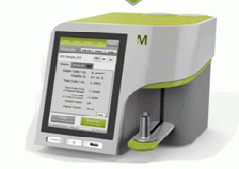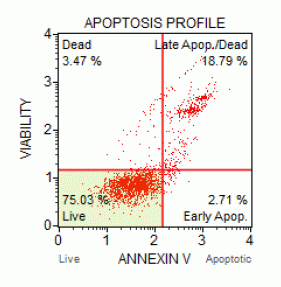The apoptosis kits analyze the range of biological events of apoptosis from decreased mitochondrial membrane potential, to the intermediate step of binding annexin V by the phospholipid, phosphatidylserine, caspase activation, and later, Bcl-2 activation in the mitochondria and DNA damage responses as detected by H2A.X expression.
The Mitopotential kit employs TMRE and 7-AAD to detect dead cells (Red fluorescence) without mitochondrial function and live cells with a variable degree of Mitopotential yellow-orange signal. Cells are labeled by incubating 100ml cells in 95ml of the Mitopotential reagent for 20 mins at 37C in the dark. Then incubate cells with 5ml of 7-AAD for 5 min at RT. Then acquire sample on Muse, see figure.
The Annexin V Kit employs PE tagged annexin V with 7-AAD as the viability marker, which are detected on the Yellow and Red parameters respectively. Cells are labeled by incubating 100,000 to 500,000 cells in 100ml of annexin V reagent for 20 mins at RT in the dark. Dead cells are 7-AAD-Annexin V-PE +ve, apoptotic cells are Annexin V-PE +ve and live cells are negative, see figure.
The Caspase 3/7 kit employs a novel cell permeant dye, NucView which under resting live cell conditions is not fluorescent. During apoptosis executioner caspases 3 & 7 are produced which cleaves NucView the product of which binds to DNA resulting in a yellow-orange fluorescence. Cells are labeled by incubating 100ml cells in 95ml of the Caspase 3/7 reagent for 30 mins at 37C in the dark. Then incubate cells with 150 ml of 7-AAD working solution for 5 min at RT. Then acquire sample on Muse, see figure.
Multicaspase kit employs a Fluorescent Labeled Inhibitor of Caspases or FLICA based VAD derivative with a fluorescent group and FMK moiety. These peptides are cell permeant and load easily into cells at 37C. These FLICA compounds bind to active caspases and become fluorescent which is proportional to the amount of active caspases within the cell. Cells are labeled by incubating 50ml cells in 5ml of the Multicaspase reagent for 30 mins at 37C in the dark. Then incubate cells with 150 ml of 7-AAD working solution for 5 min at RT. Then acquire sample on Muse, see figure.
The Bcl-2 activation dual parameter kit employs a phospho specific Ser70 anti-Bcl-2 antibody tagged with AlexFluor555 and a general anti-Bcl-2-PE-Cy5 antibody to measure the total level off Bcl-2 allowing the determination of the ratio of phospho: total ratio in a mixed cell population. Bcl-2 regulates apoptosis by regulating proteins that control inner mitochondrial membrane permeability. When cells receive an apoptotic signal, Bcl-2 releases Bax, allowing Bax to form a complex on the mitochondrial membrane that releases cytochrome C into the cytoplasm leading to caspase activation and cell death. The kit is supplied with fix and perm reagents, cells are incubated 5 min each for fix and perm of cell membranes. The antibodies are supplied as a cocktail with 10ml being incubated with 200,000 cells in 200ml of Assay Buffer. After washing samples are acquired on the Muse, see figure.
The H2A.X Activation dual parameter kit which includes a pair of antibodies that bind to the same protein; one to detect total protein expression and another to detect the phosphorylated form of the same target. So by using two parameter analysis, we can achieve target specific detection of phosphorylation and, by doing so, eliminate false positives while enhancing the signal to noise ratio. Phosphorylation of Histone H2A.X at serine 139 is an important indicator of DNA damage. As the level of DNA damage increases, the level of phospho Histone H2A.X increases, accumulating at the sites of DNA damage, this is used to indicate the level of DNA damage present within the cell. In order to validate that the level of H2A.X activation is accurate, a total H2A.X antibody is multiplexed to allow the total and phospho levels Histone doubles in content during the cell cycle at the same rate DNA content doubles. Having a total H2A.X will account for this increase, so the phosphorylated levels can be accurately determined. The Muse™ H2A.X Activation Dual Detection Kit includes two directly conjugated antibodies, a phospho-specific anti-phospho-Histone H2A.X (Ser139)-Alexa Fluor®555 and an anti-Histone H2A.XPECy5 conjugated antibody to measure total levels of Histone H2A.X. The staining protocol is identical to the Bcl-2 staining kit, see figure.
- Mitopotential kit
- Mitopotential quick reference card
- Annexin V kit
- Annexin V quick reference card
- Caspase 3/7 kit
- Caspase 3/7 quick reference card
- Multicapase kit
- Multicaspase quick reference card
- Bcl-2 Activation Dual parameter kit
- H2A.X Activation Dual parameter kit
- User Manual


